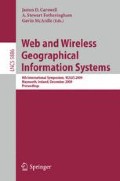Abstract
Web personalization can be seen as an interdisciplinary domain that facilitates interaction between web content and user needs. One of the peculiarities of Web information is that a significant part of the data is georeferenced although this is not completely taken into account by current search and personalization engines. This paper introduces a spatial personalization approach based on a user modeling technique and a measure of spatial accessibility. We develop a personalized accessibility measure whose objective is to predict and evaluate location relevancy, accessibility and associations at the user level. This measure favors delivery of location-based and personalized recommendations.
Access this chapter
Tax calculation will be finalised at checkout
Purchases are for personal use only
Preview
Unable to display preview. Download preview PDF.
References
Makri, M.C., Folkesson, C.: Accessibility measures for analyses of land use and traveling with geographical information systems. In: Proceedings of the 2nd KFB-Research Conference, June 1999, pp. 1–17 (1999)
Handy, S.L., Niemeier, D.A.: Measuring accessibility: an exploration of issues and alternatives. Environment and Planning A 29(7), 1175–1194 (1997)
Batty, M.: A new theory of space syntax. UCL working papers series (75) (2004)
Stan, C., Geertman, M., van Eck, J.R.R.: GIS and models of accessibility potential: An application in planning. International Journal of Geographical Information Systems 9(1), 67–80 (1995)
Song, S.: Some tests of alternative accessibility measures: A population density approach. Land Economics 4, 474–482 (1996)
Pirie, G.H.: Measuring accessibility: a review and proposal. Environment and Planning A 11(3), 299–312 (1979)
Kwan, M.: Space-time and integral measures of individual accessibility: A comparative analysis using a point-based framework. Geographical Analysis 30(3), 191–216 (1998)
Oberg, S.: Methods of describing physical access to supply points. Lund Studies in Geography, Series B, Human Geography 42, 474–482 (1976)
Wachs, M., Kumagai, T.G.: Physical accessibility as a social indicator. Socio-Economic Planning Sciences 7(5), 437–456 (1973)
Black, J., Conroy, M.: Accessibility measures and the social evaluation of urban structure. Environment and Planning A 9, 1013–1031 (1977)
Burnett, P., Hanson, S.: An analysis of travel as an example of complex human behavior in spatially constrained situations. Transportation Research 16, 87–102 (1982)
Sonesson, C.: Evaluations of some exponentially weighted moving average methods. Journal of Applied Statistics 30(10), 1115–1133 (2003)
Kwan, M.P., Hong, X.D.: Network-based constraints-oriented choice set formation using GIS. Geographical Systems 5, 139–162 (1998)
Ingram, D.: The concept of accessibility: A search for an operational form. Regional Studies 5(2), 101–107 (1971)
Burnett, P.: Spatial constraints-oriented modelling as an alternative approach to movement, microeconomics theory and urban policy. Urban Geography 1, 53–67 (1980)
Petit, M., Claramunt, C., Ray, C., Calvary, G.: A design process for the development of an interactive and adaptive GIS. In: Bertolotto, M., Ray, C., Li, X. (eds.) W2GIS 2008. LNCS, vol. 5373, pp. 96–106. Springer, Heidelberg (2008)
Mac Aoidh, E., Bertolotto, M., Wilson, D.: Implicit profiling for contextual reasoning about users’ spatial preferences. In: Proceedings of 2nd Workshop on Case Based Reasoning and Context-Awareness, August 2007. CEUR Workshop Proceedings, vol. 271 (2007) ISSN 1613-0073
Kelly, D., Belkin, N.: Reading time, scrolling and interaction: Exploring implicit sources of user preferences for relevant feedback. ACM Special Interest Group on Information Retrieval, 408–409 (2001)
Author information
Authors and Affiliations
Editor information
Editors and Affiliations
Rights and permissions
Copyright information
© 2009 Springer-Verlag Berlin Heidelberg
About this paper
Cite this paper
Haddad, M.R., Baazaoui, H., Aufaure, M.A., Claramunt, C., Lechevallier, Y., Ghezala, H.B. (2009). Towards an Integration of Space and Accessibility in Web Personalization. In: Carswell, J.D., Fotheringham, A.S., McArdle, G. (eds) Web and Wireless Geographical Information Systems. W2GIS 2009. Lecture Notes in Computer Science, vol 5886. Springer, Berlin, Heidelberg. https://doi.org/10.1007/978-3-642-10601-9_4
Download citation
DOI: https://doi.org/10.1007/978-3-642-10601-9_4
Publisher Name: Springer, Berlin, Heidelberg
Print ISBN: 978-3-642-10600-2
Online ISBN: 978-3-642-10601-9
eBook Packages: Computer ScienceComputer Science (R0)

